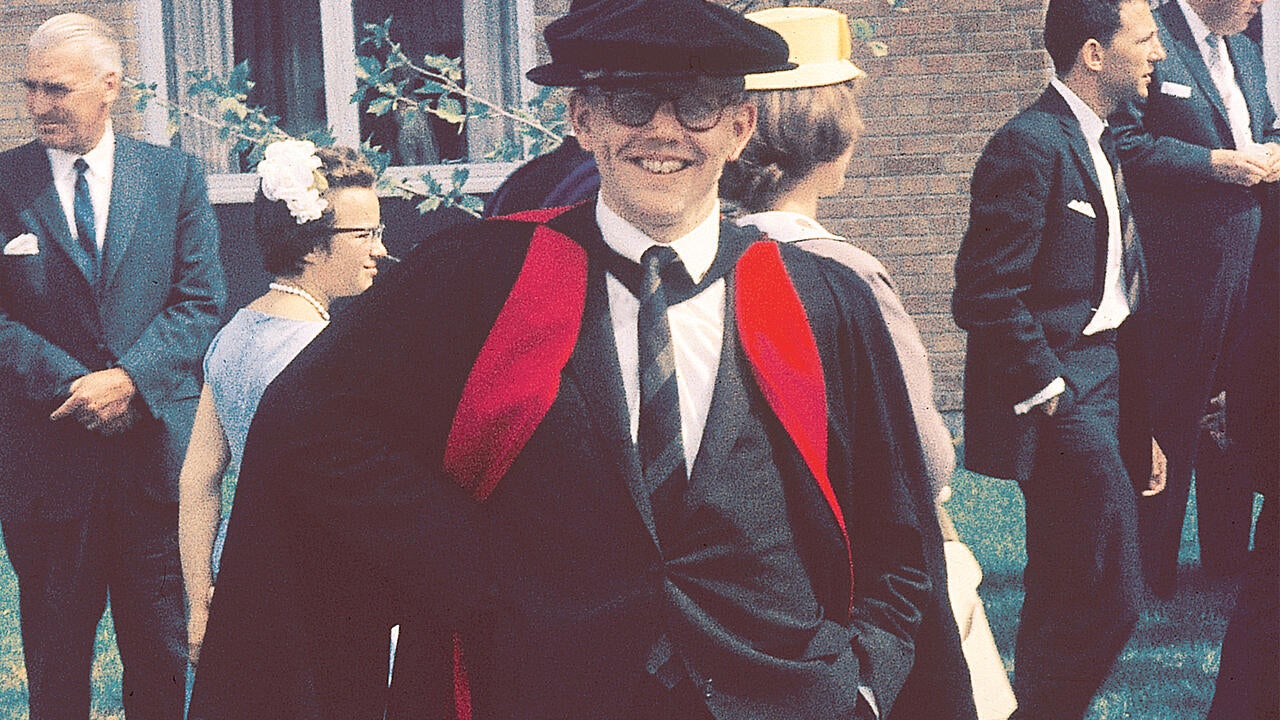
Waterloo Remembers President Emeritus Douglas Wright
Douglas Tyndall Wright, the University of Waterloo’s third president and vice-chancellor, as well as its founding dean of engineering has died.

Douglas Tyndall Wright, the University of Waterloo’s third president and vice-chancellor, as well as its founding dean of engineering has died.
By Media Relations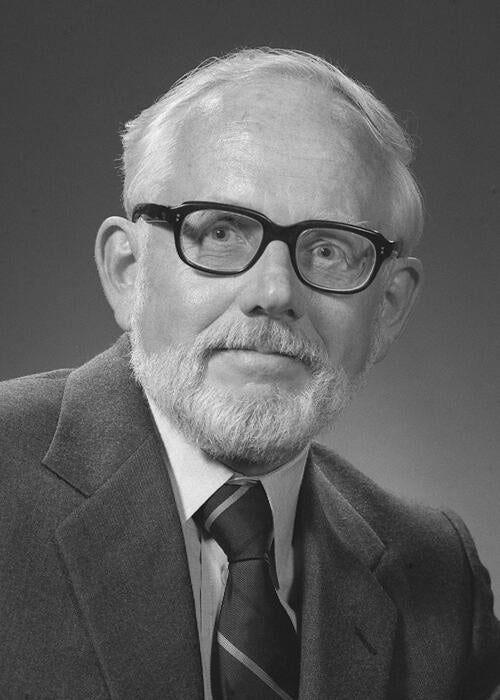
Douglas Tyndall Wright
> University of Waterloo's third president and vice-chancellor
> Founding dean of engineering
Douglas Tyndall Wright, the University of Waterloo’s third president and vice-chancellor, as well as its founding dean of engineering has died. He was 92.
Wright was Waterloo’s president and vice-chancellor from 1981 to 1993. During his tenure, he moved the University into a whole new level of applied knowledge, patents and technology transfer. Major computer companies saw the advantage of supporting the University by providing equipment and research dollars. For example, Digital Equipment’s $24 million donation bought eight new VAX machines that made it possible to computerize both the Oxford English Dictionary and develop the software, leading to the creation of Waterloo spinoff successes MapleSoft and OpenText.
He left a teaching position at Queen’s University to join a young upstart University of Waterloo in 1958 as the first chair of civil engineering. He soon became the first dean of engineering. While he was dean, Waterloo became the largest undergraduate engineering school in the country. After returning from an educational conference of the Engineering Institute of Canada, Wright noted what he referred to as inertia at other institutions, which showed an unwillingness to change their customs and curriculum. The Faculty introduced its own curriculum based on co-operative education. He removed courses that seemed less relevant to what was happening in industry. The Engineering 1 building that bears his name was UWaterloo’s first academic building.
Wright left the University for a post at Queen’s Park. He became a deputy minister in 1967 with responsibilities initially for university financing, and subsequently, for social policy with the Cabinet Committee for Social Development. In 1969, in response to concern about the mounting provincial costs for university education, the Honourable William Davis, then minister of education, put Wright in charge of the province’s Committee on University Affairs. Wright chaired the Commission on Post-Secondary Education in Ontario. From 1979 to 1980, he was deputy minister of culture and recreation.
He came back the University as president, and would lead it for nearly 12 years, throughout the 1980s and early part of the 1990s.
“His return to Waterloo as our third president signalled a return to the no- holds-barred restlessness and momentum of the founding years. Limiting precedents and policies may have been put in place, but more significantly, Doug Wright was primarily interested in challenges to be pursued,” said Ken McLaughlin, historian and author. “He had a relentless curiosity compounded by a drive for relevance in university life and practice, along with a sense that in Canada we needed to change the university landscape. He pushed, prodded and pulled us with him as he pursued academic excellence and social relevance.”
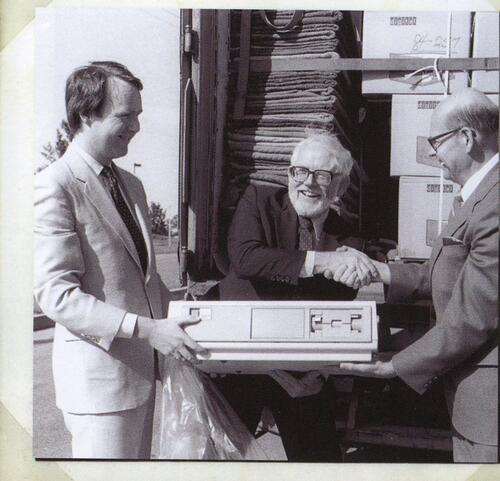
Former Waterloo president Douglas Wright (centre) in 1984 unpacking a $24 million donation of computing equipment from DEC that made it both possible to computerize the Oxford English Dictionary and develop software that launched Waterloo Maple.
Waterloo celebrated its 25th anniversary in 1982. On March 17 of that year, the University launched two major initiatives: the Watfund fund-raising campaign and the Institute for Computer Research. When Watfund was launched, it had a goal of $21 million, but it had already brought in $8 million. In December of that year, partnerships between Waterloo and IBM Canada worth $17 million included software, hardware, employment and research. The IBM deal was the largest gift ever received by the University at that time.
“Doug Wright was one of the most important influences on the establishment of two of the principal characteristics of who we are at Waterloo: Co-op and the value of experiential learning, and the principles of entrepreneurship, risk-taking and individual initiative,” said Rick Haldenby, a professor in Waterloo’s School of Architecture, and who first met Wright in 1969. “His guiding of the overall development of the infrastructure of post-secondary education in the 1960s and ‘70s is absolutely vital. Anyone going to university in Ontario today is part of the legacy of Doug Wright.”
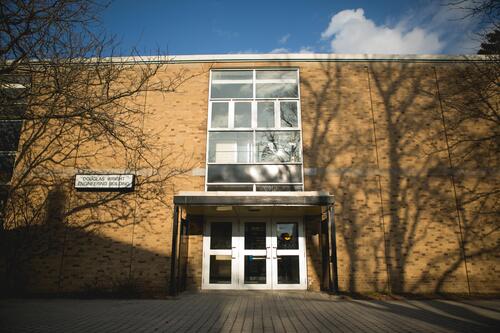
The Douglas Wright Engineering Building is the oldest building on campus, constructed in 1958.
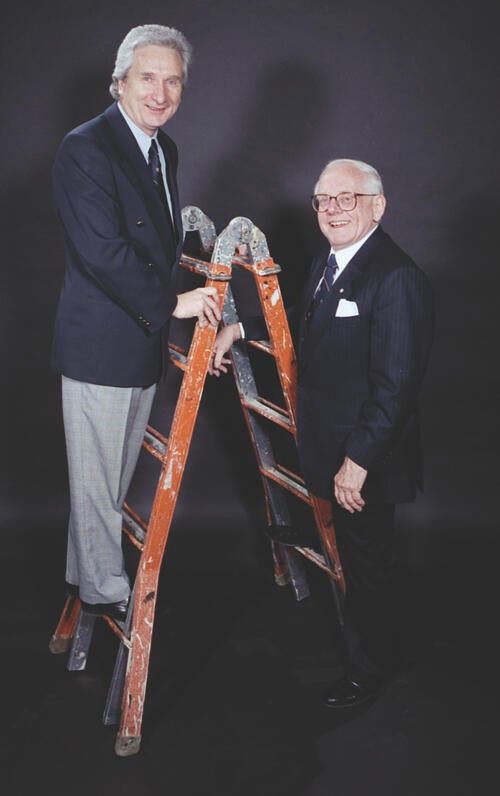
The ladder of succession: James Downey, the incoming president, ascends and Douglas Wright, the outgoing president, watches happily. (Courtesy of Special Collections & Archives, University of Waterloo.)
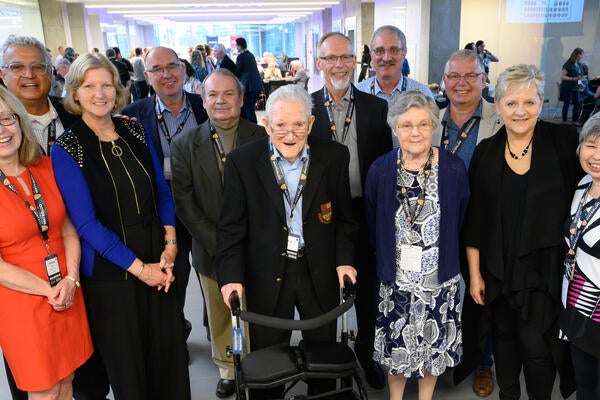
Read more
A respected and long-time chemical engineering professor dies in his 100th year
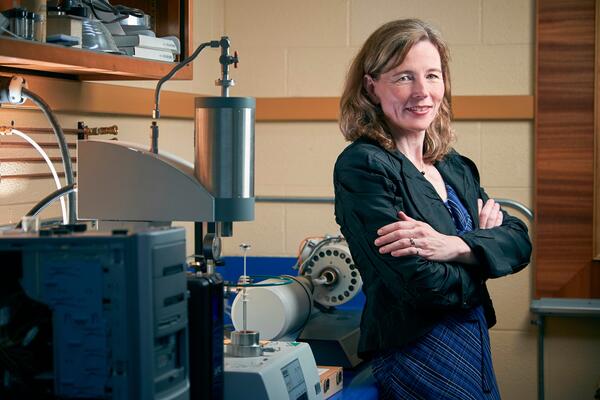
Read more
Mary Wells, the incoming dean of Waterloo Engineering, highlights the impact and the importance of the profession during the coronavirus pandemic - and once it is over

Read more
Four engineering grads were on Thornhill Medical team that designed and developed a portable life support and ventilator device now being produced for the coronavirus fight
The University of Waterloo acknowledges that much of our work takes place on the traditional territory of the Neutral, Anishinaabeg, and Haudenosaunee peoples. Our main campus is situated on the Haldimand Tract, the land granted to the Six Nations that includes six miles on each side of the Grand River. Our active work toward reconciliation takes place across our campuses through research, learning, teaching, and community building, and is co-ordinated within the Office of Indigenous Relations.